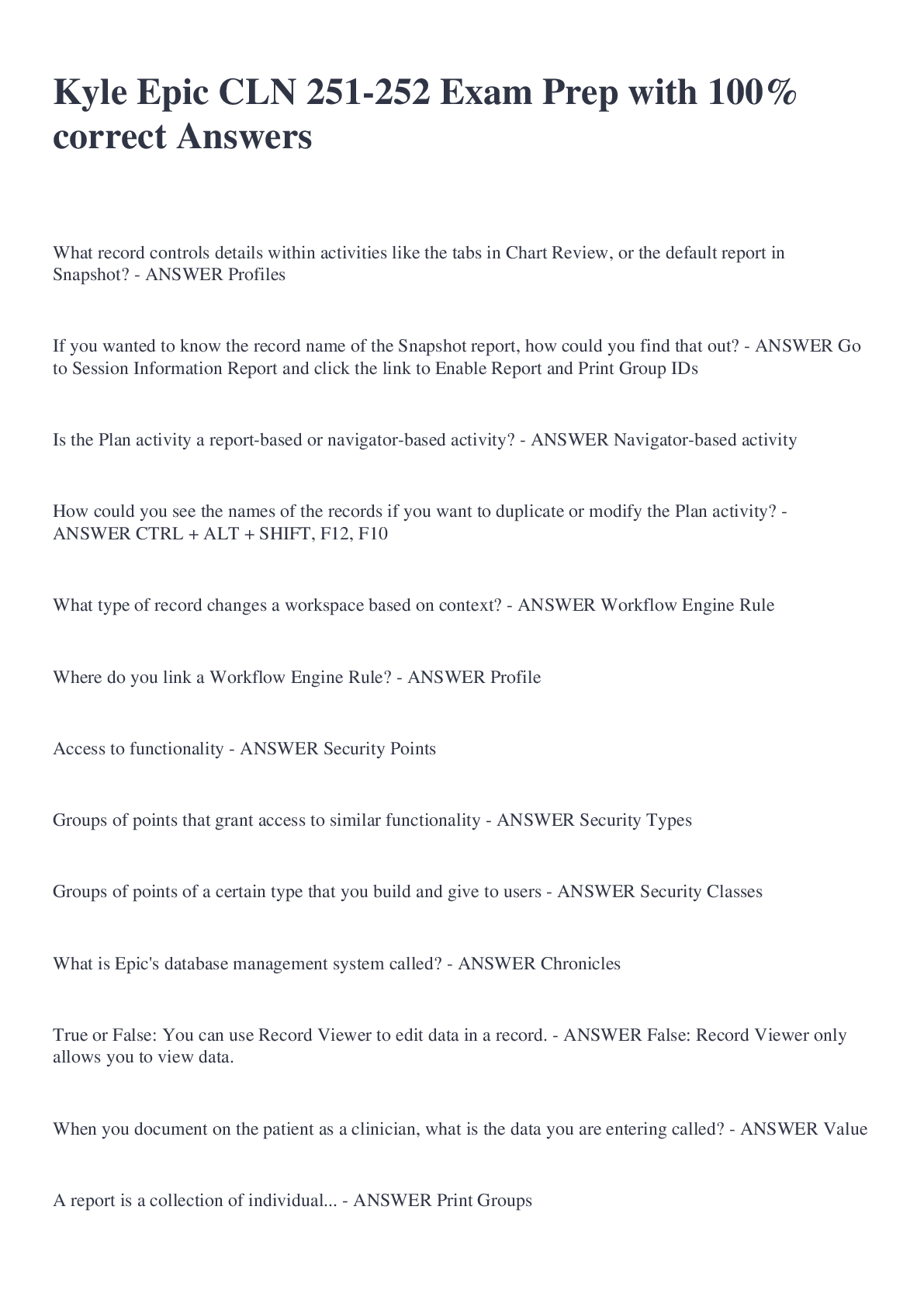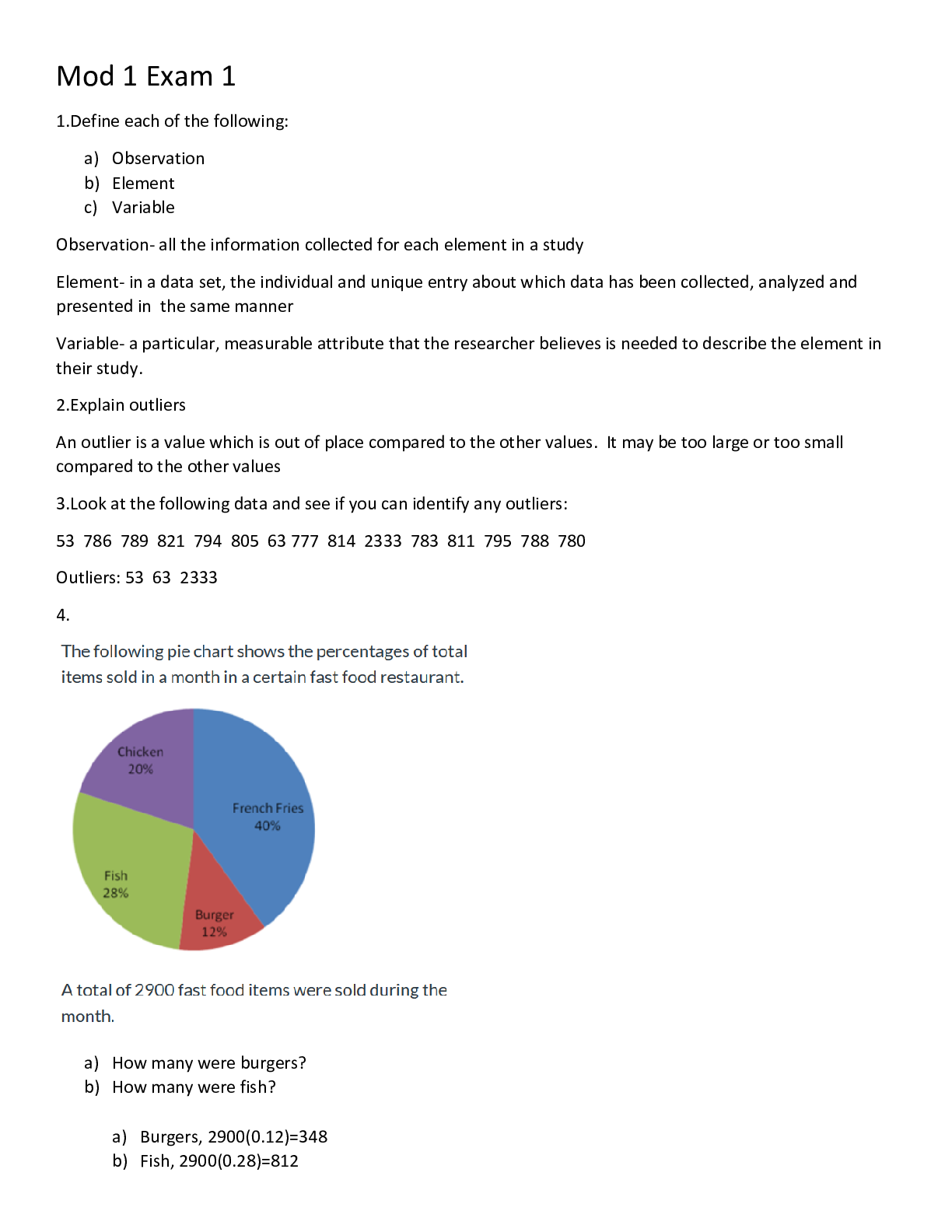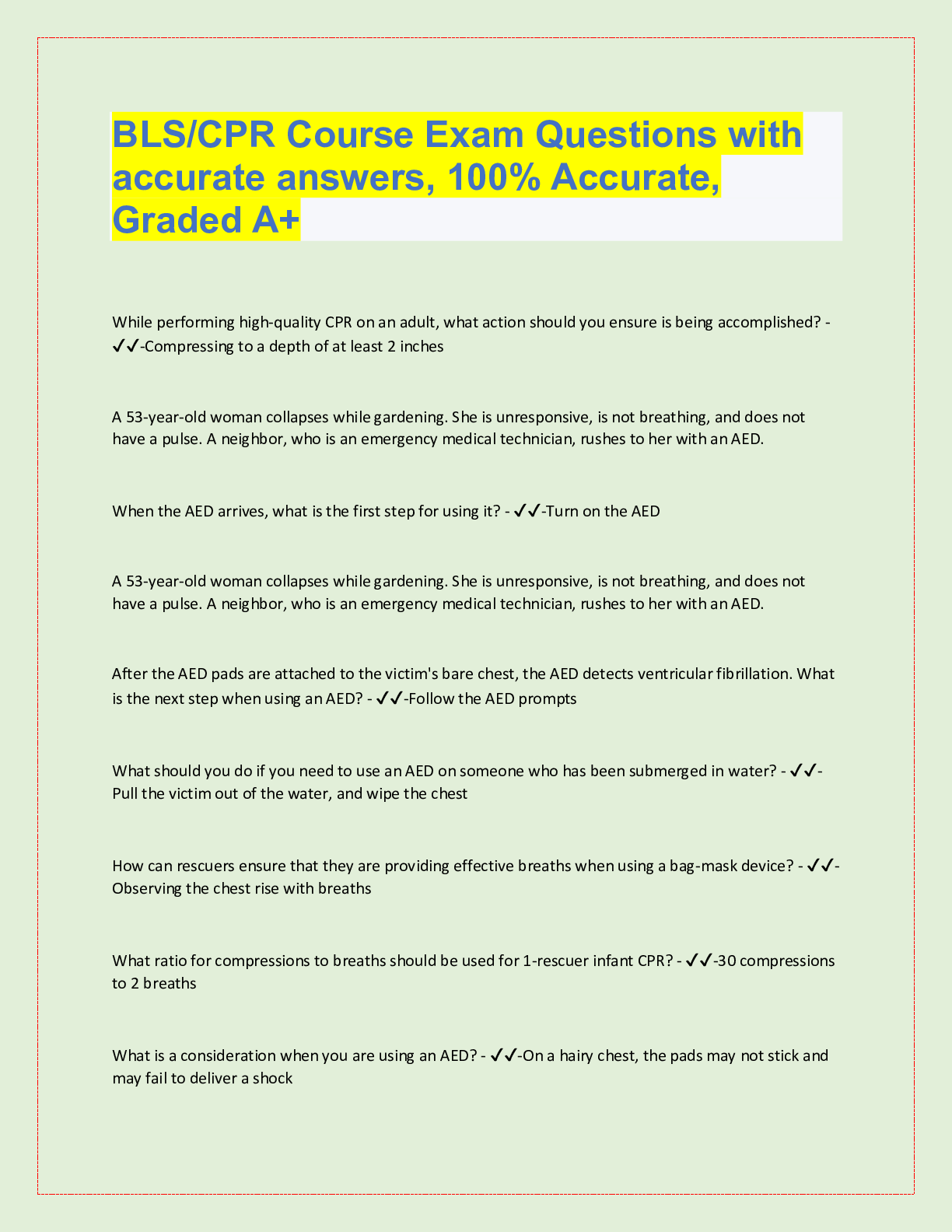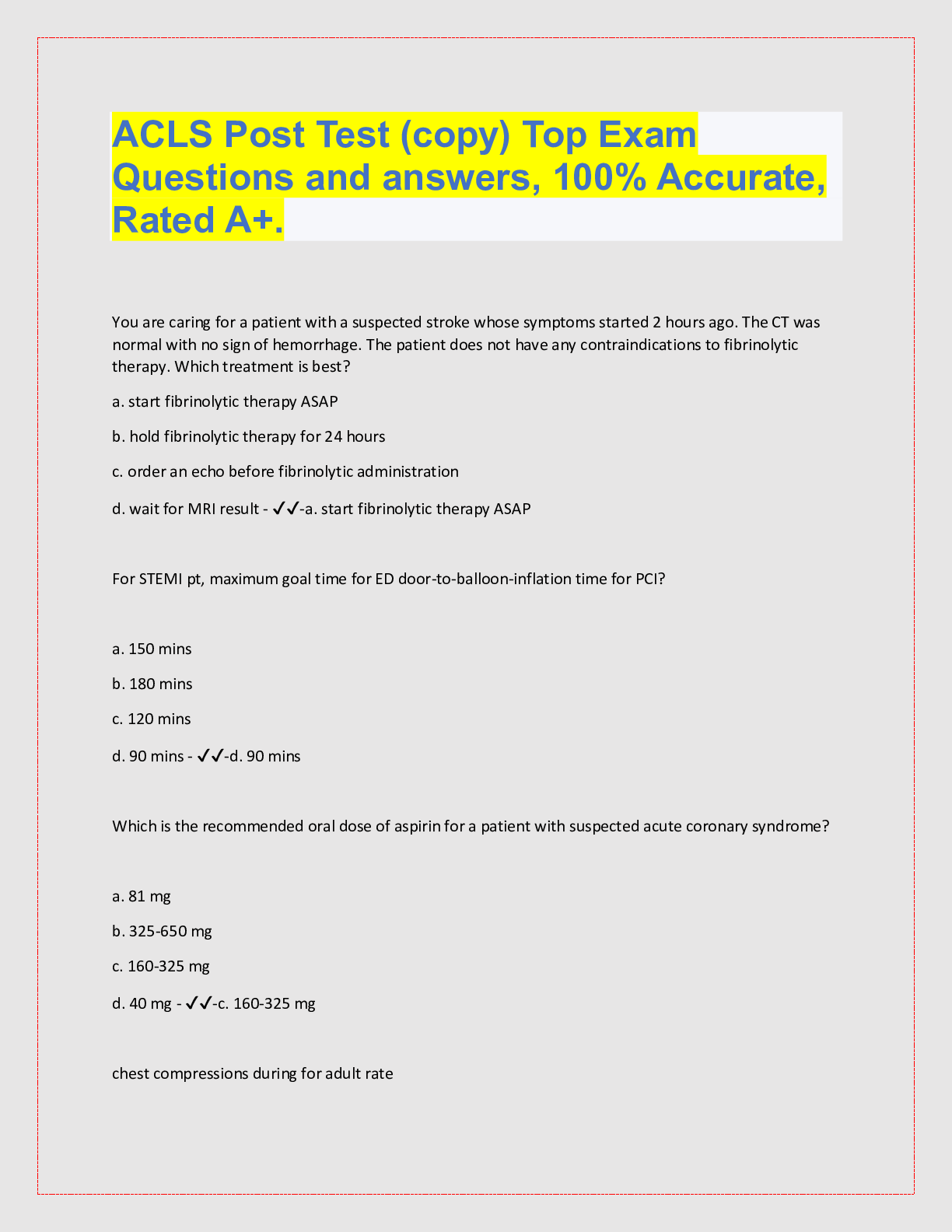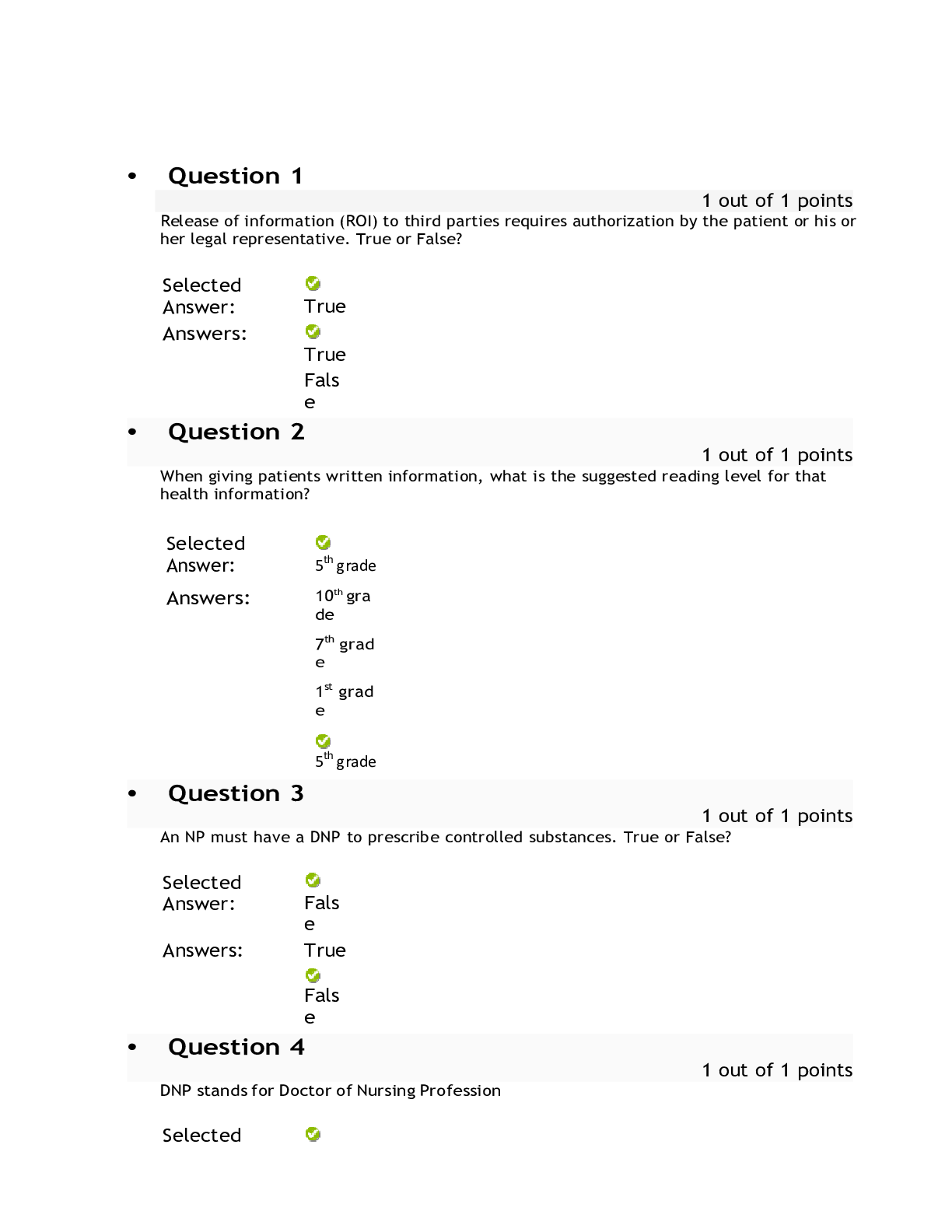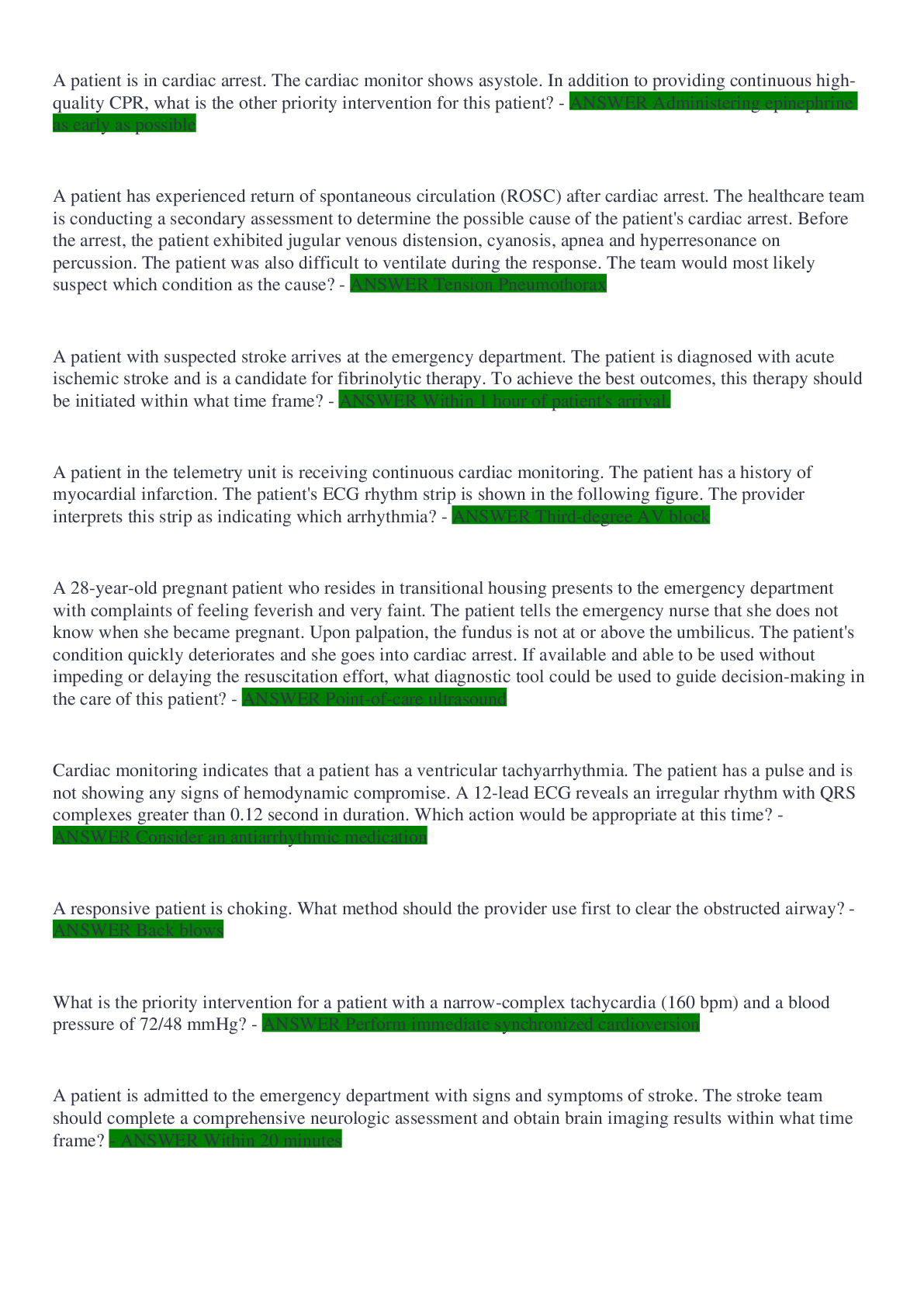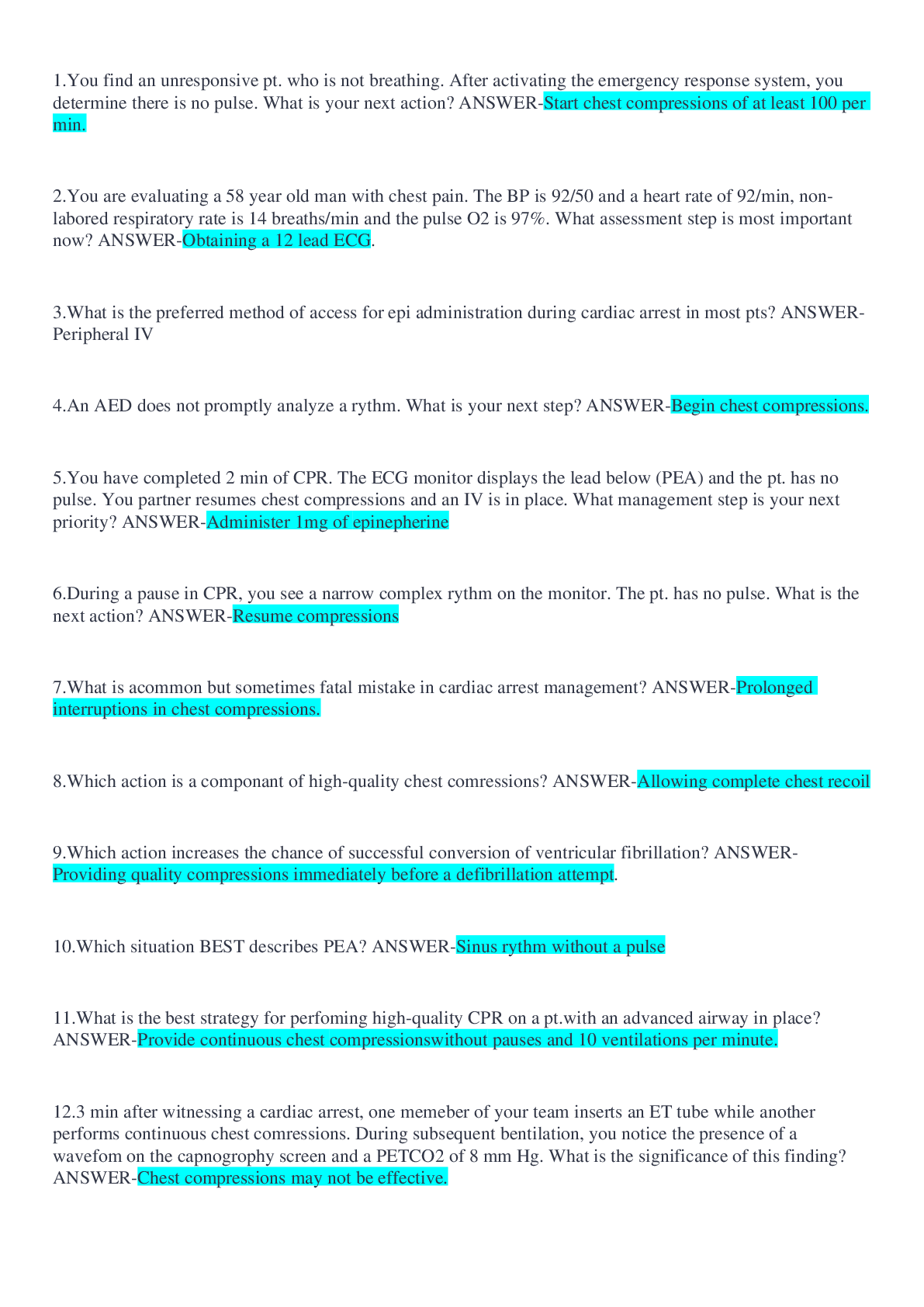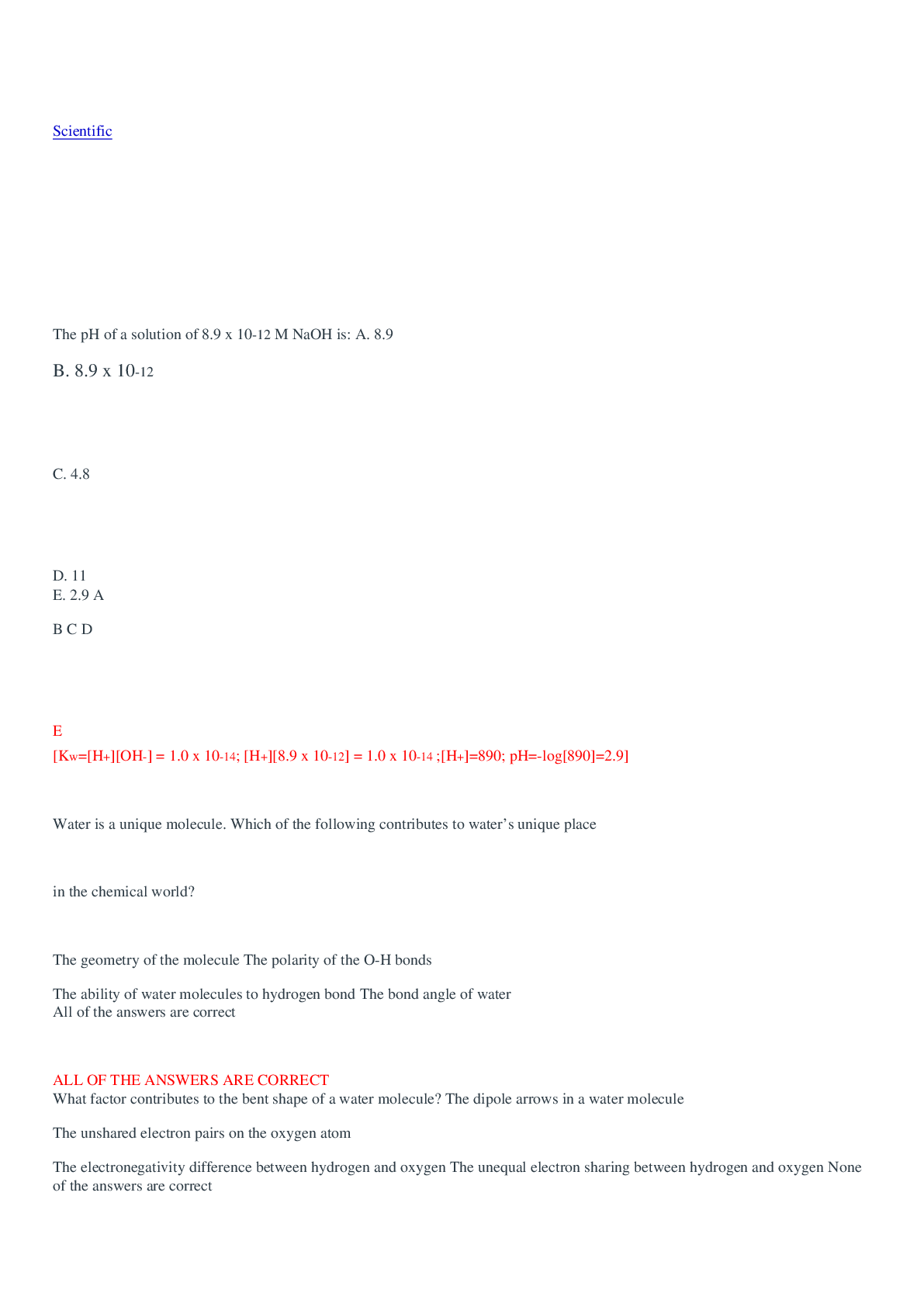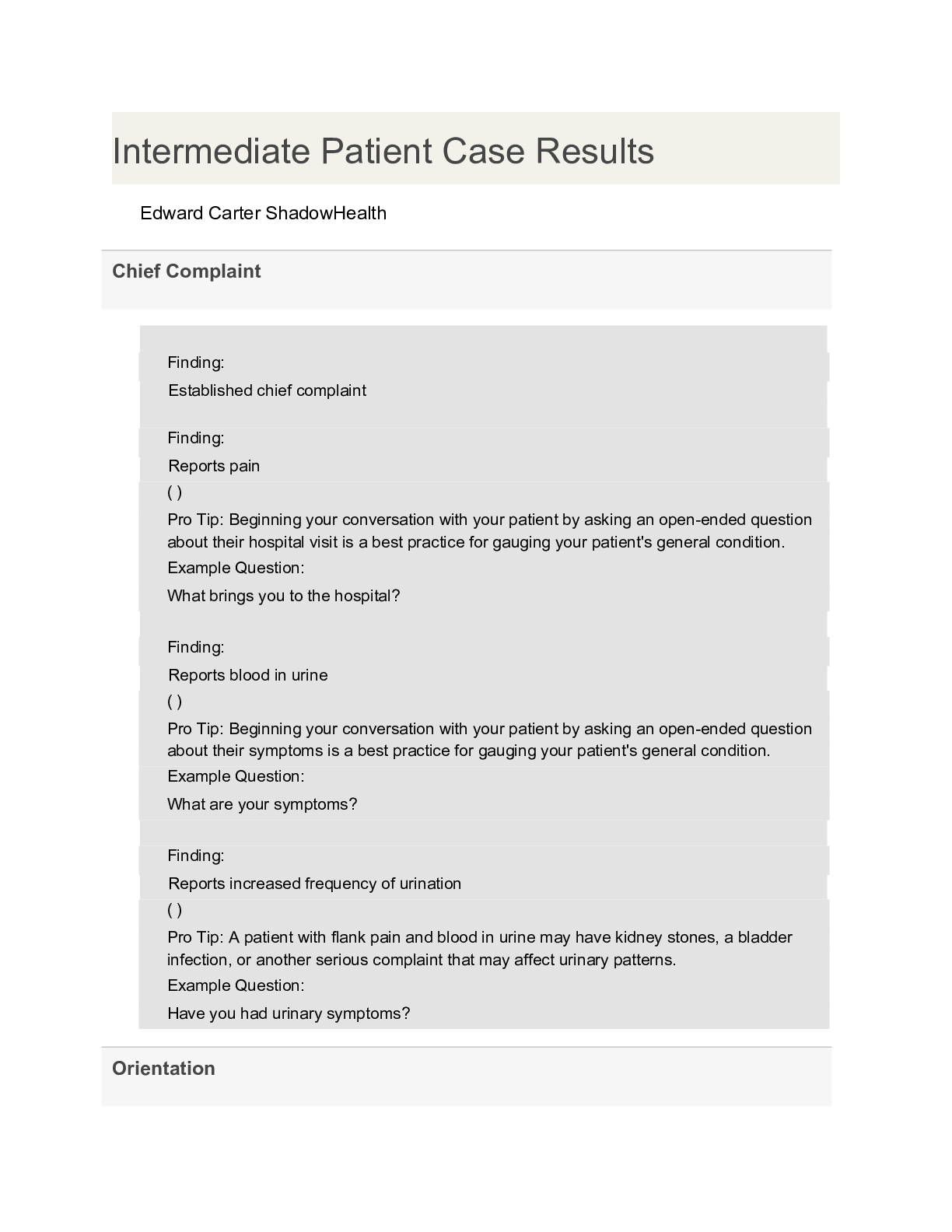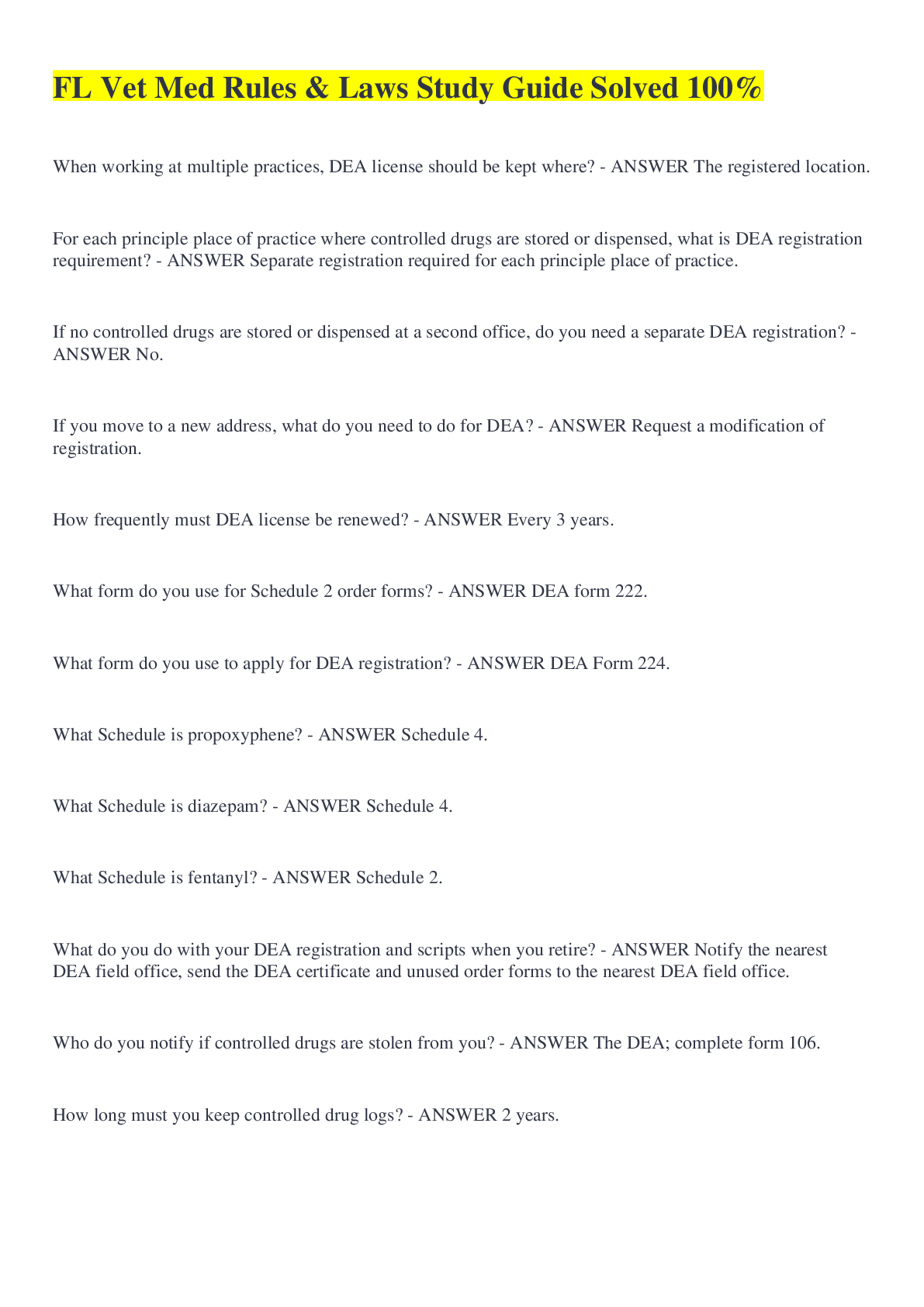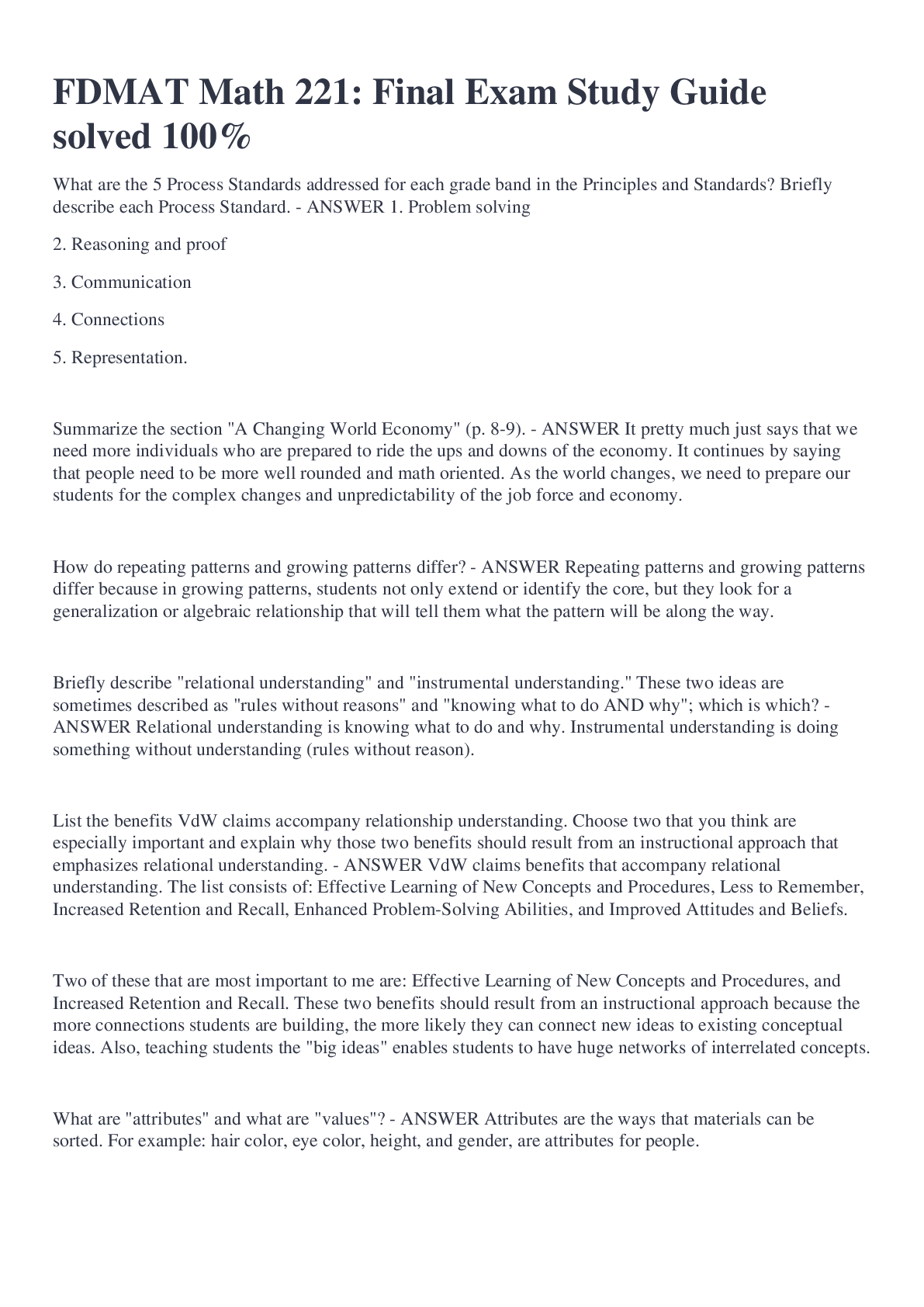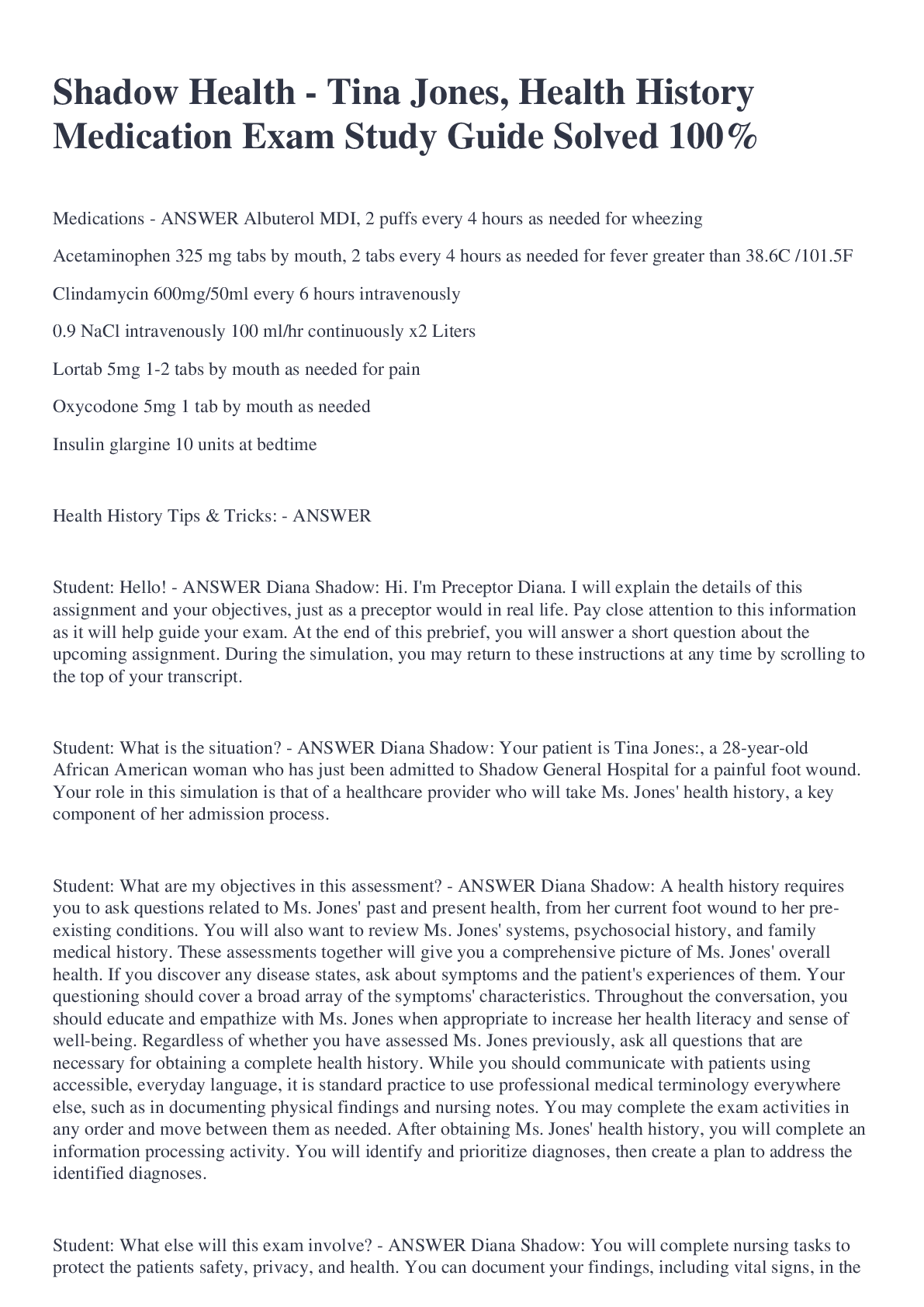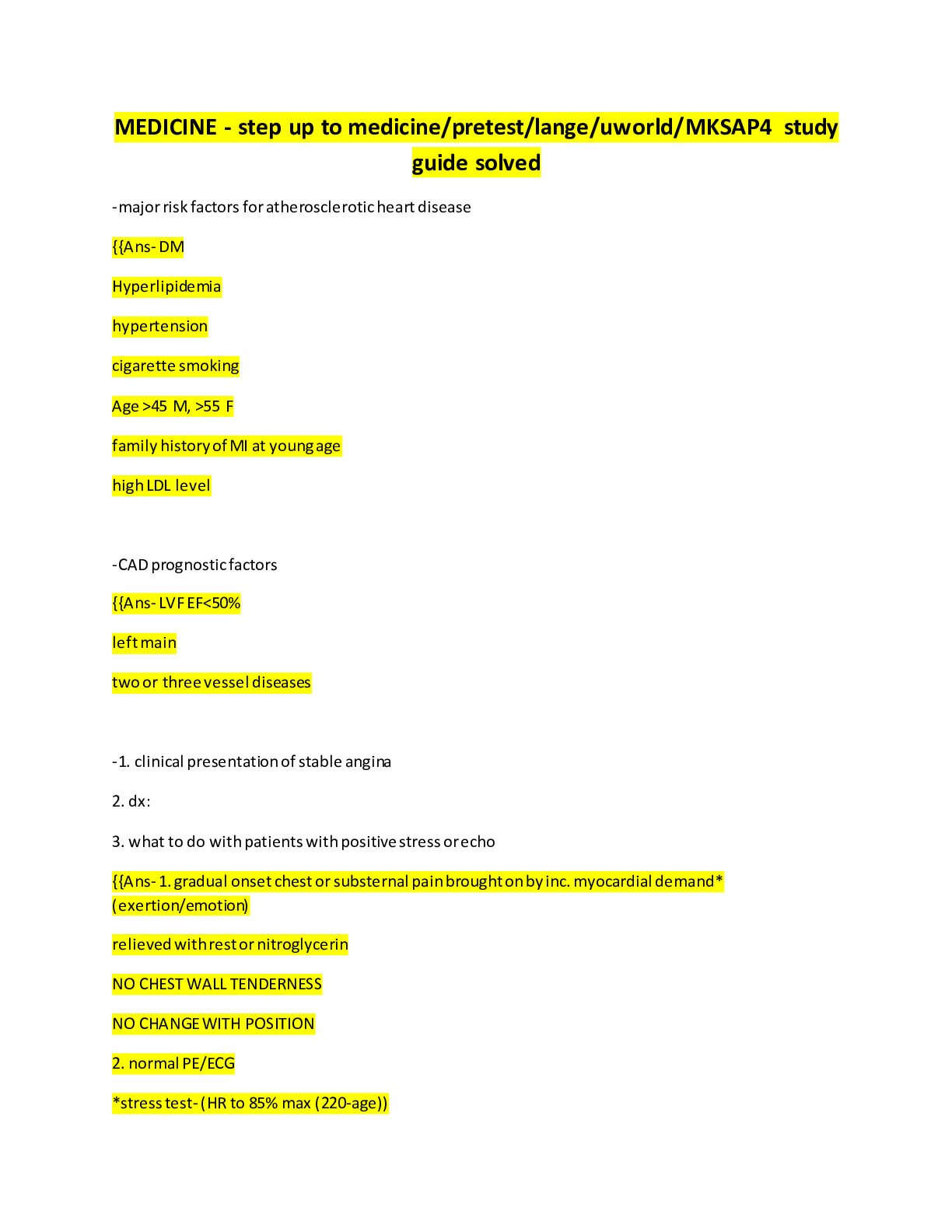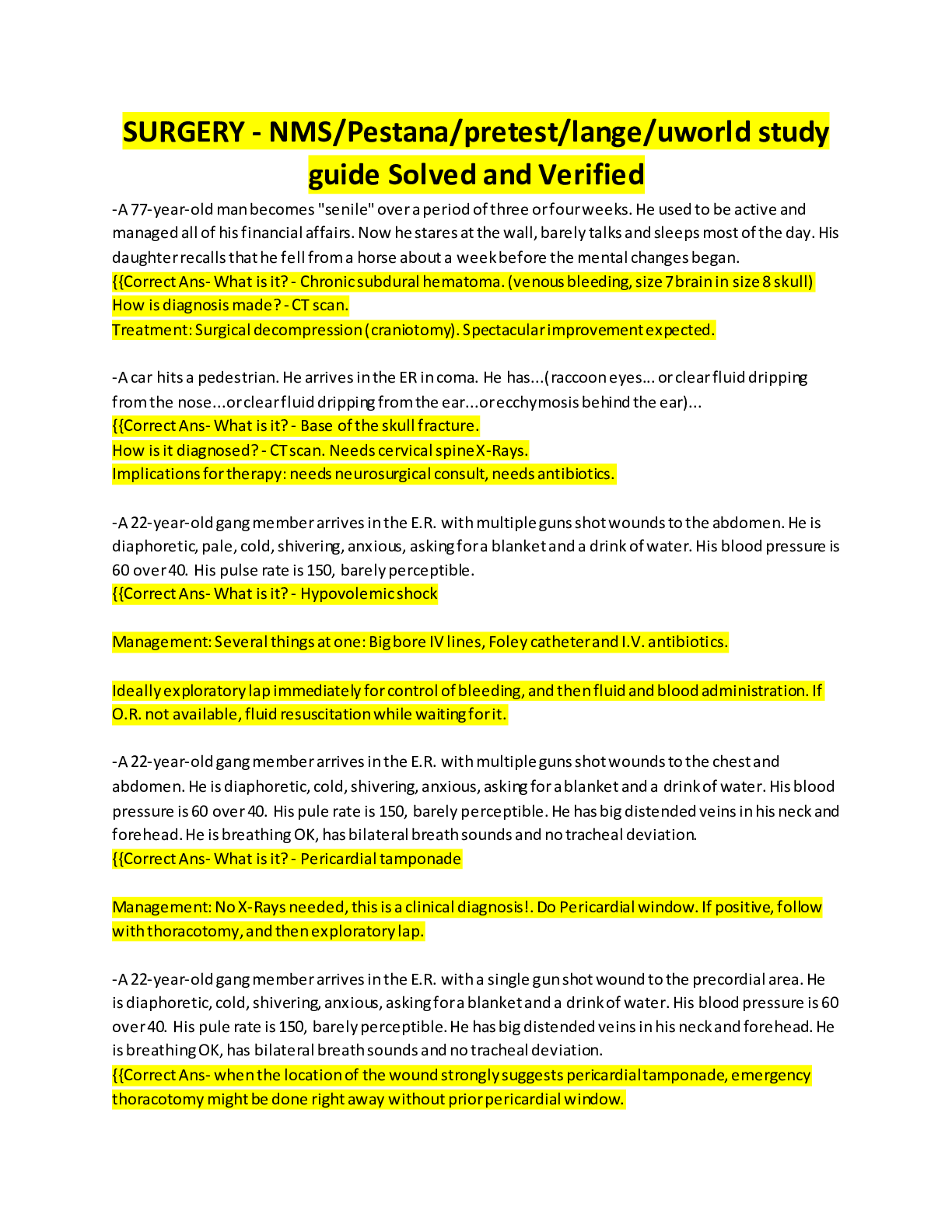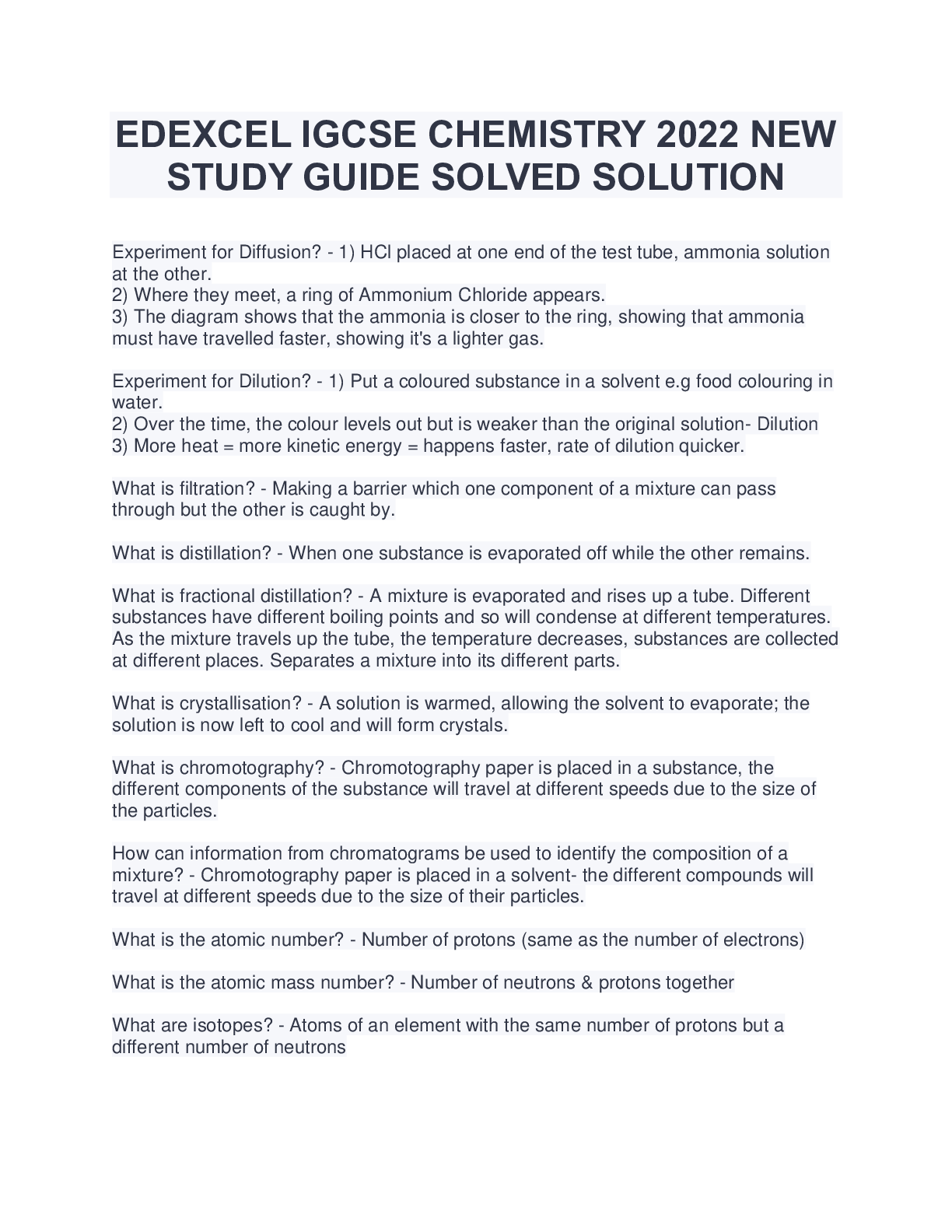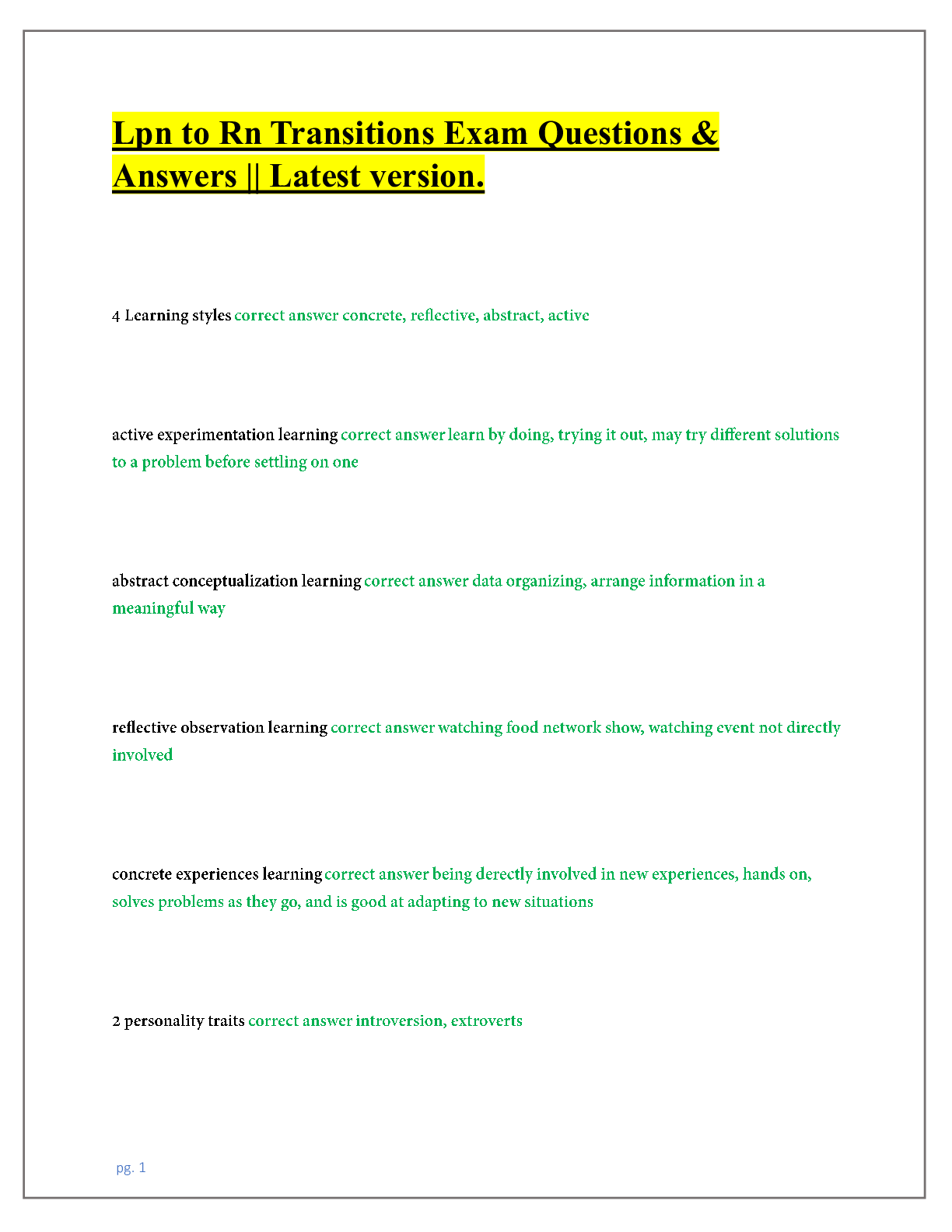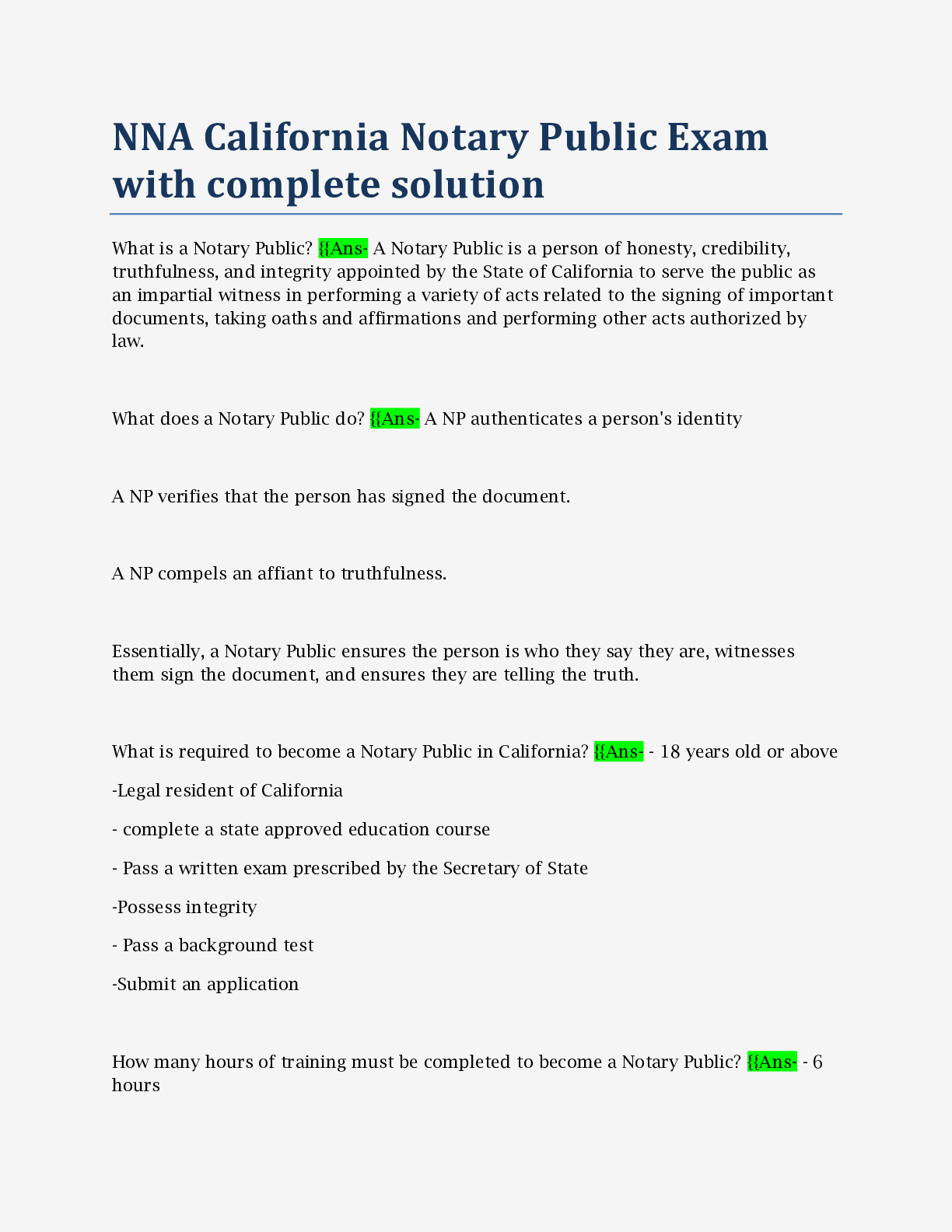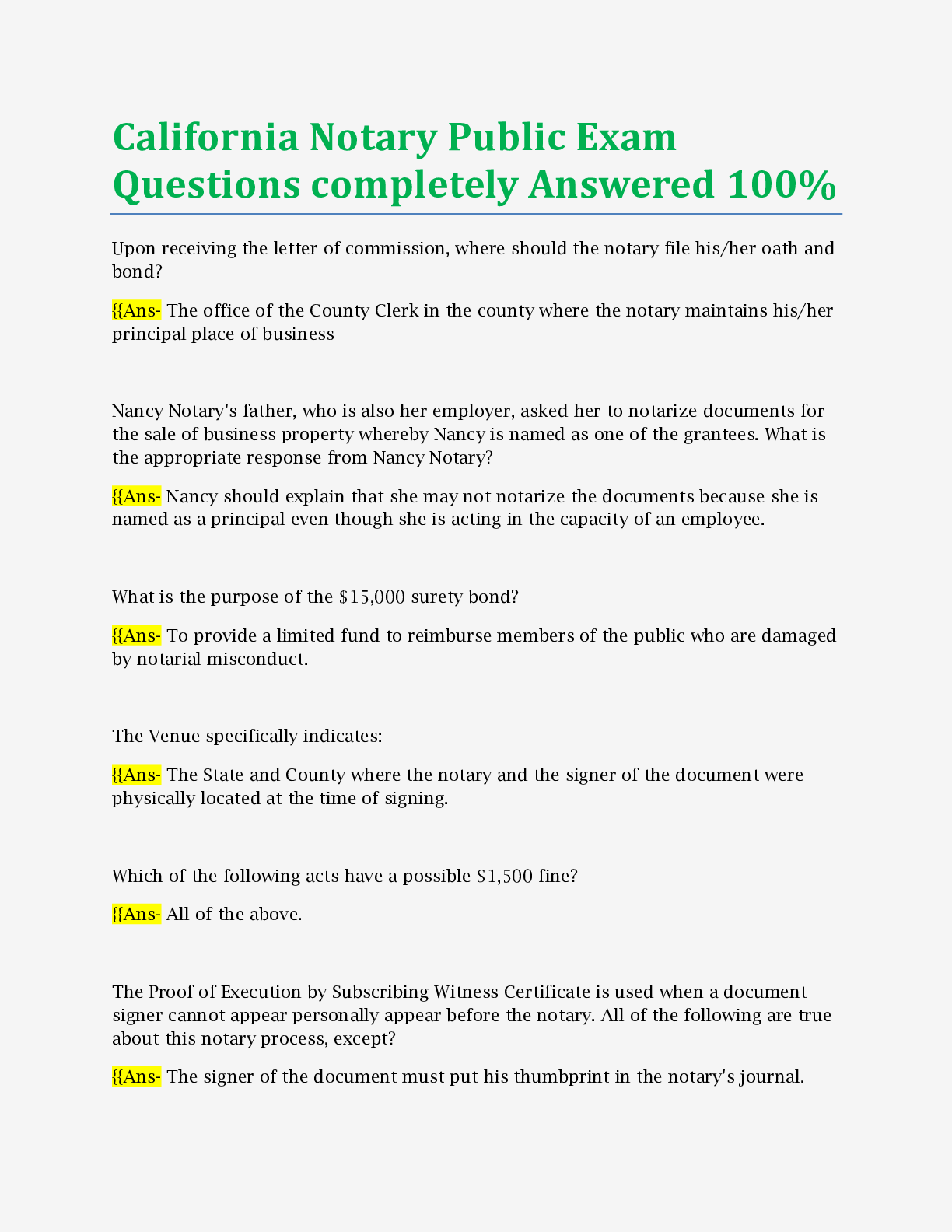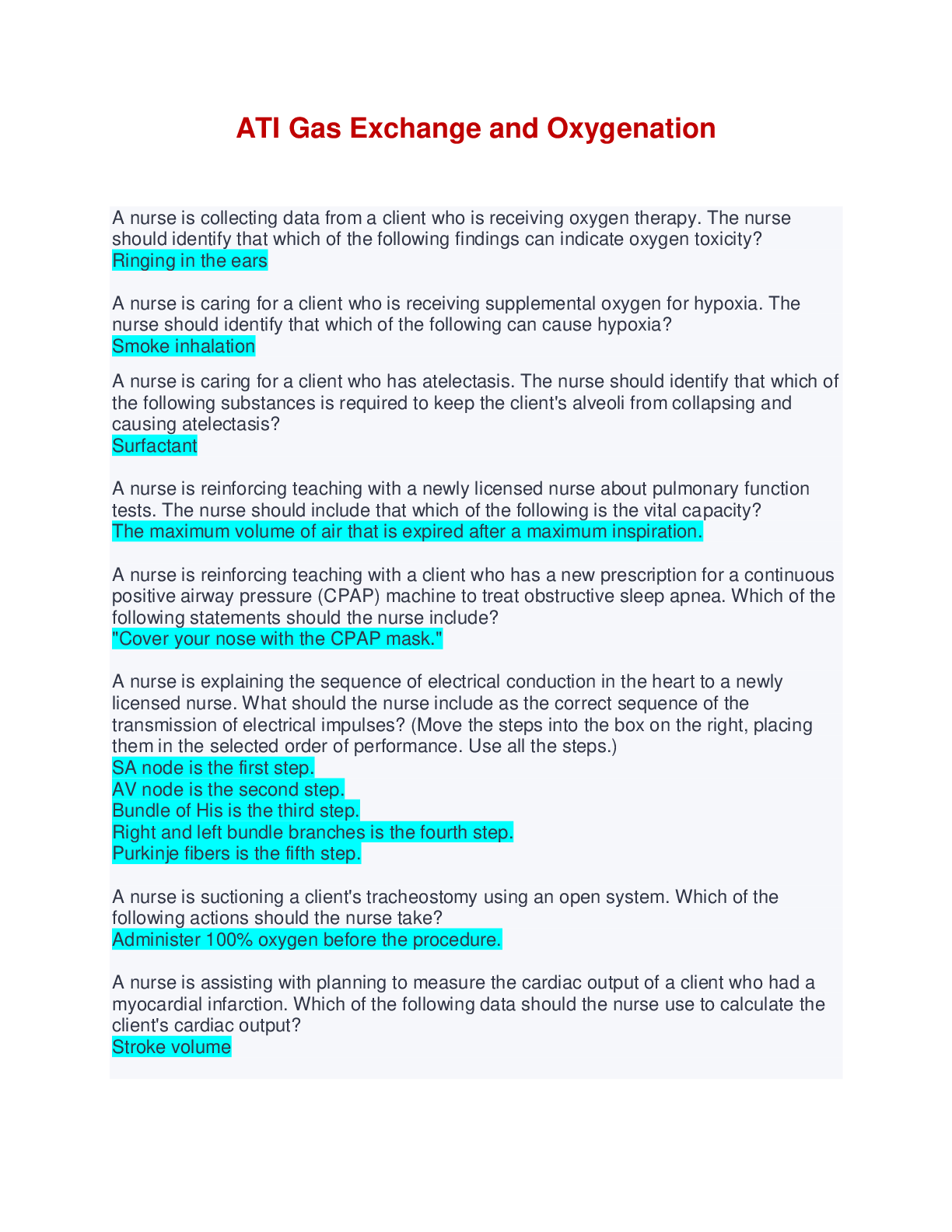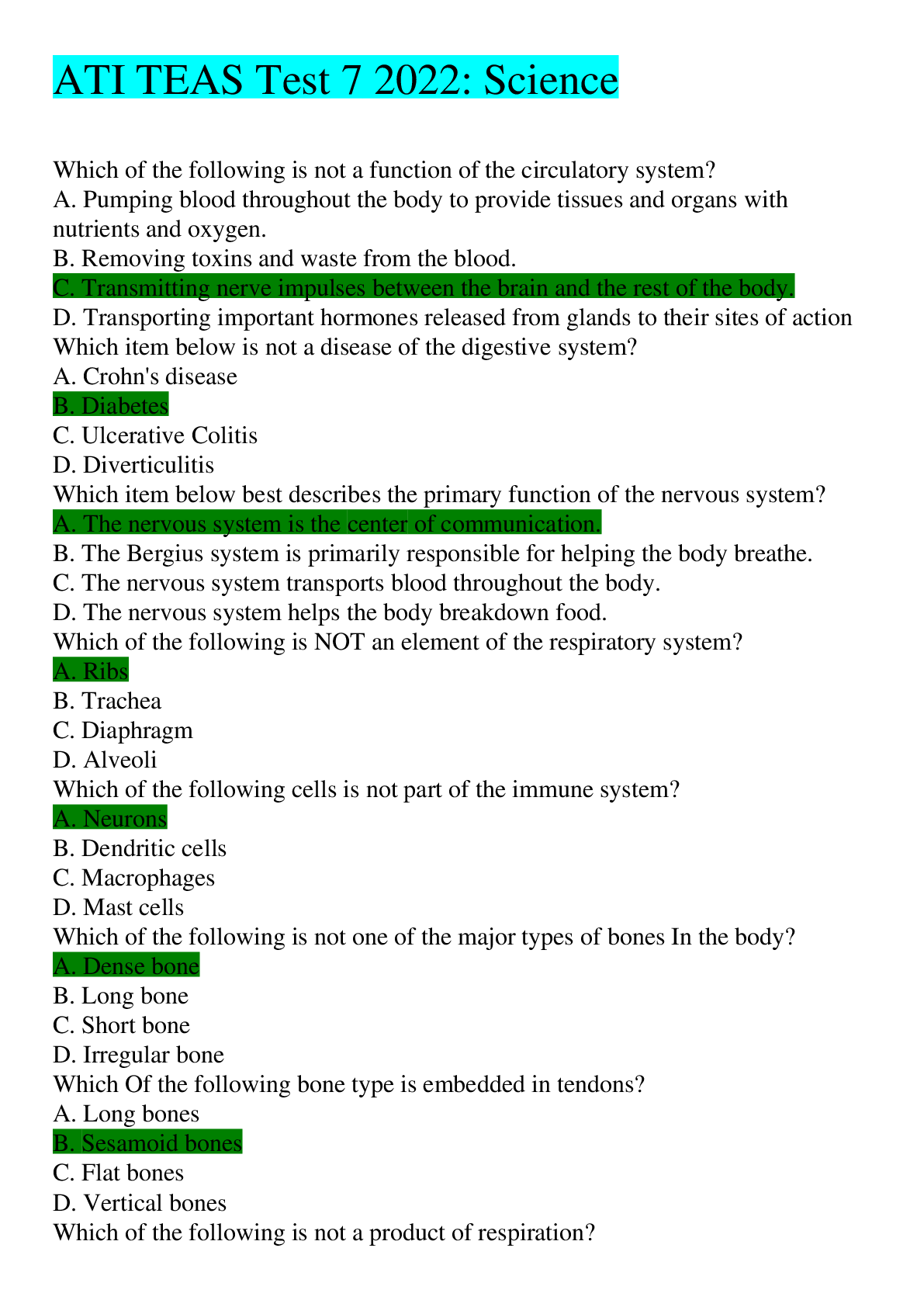Government > EXAM > CA Exam Study Guide Solved 100% (All)
CA Exam Study Guide Solved 100%
Document Content and Description Below
Californians have attitudes toward government described as a. trust. b. distrust. c. complete indifference. d. significant engagement. - ANSWER : b Governor Jerry Brown is known to say that a... . government is necessary. b. public decisions are all local. c. policy making lacks consensus. d. people are largely indifferent. - ANSWER : c In the 1500s, the Spanish viewed California as a(n) a. new continent. b. mythical island. c. religious sanctuary. d. untamed world. - ANSWER : b California's motto is a. Ying and Yang. b. Eureka. c. Geronimo. d. Aquira Semper. - ANSWER : b Political systems in California involve a. control and influence b. power and authority c. both A and B d. diversity - ANSWER : c Which of these are found in abundance in the northern part of California? a. Dry deserts b. Palm trees c. Rock formations d. Thick forests - ANSWER : d Public policymaking is described as a. the authoritative allocation of values. b. who gets what, when and how. c. power and authority. d. pursuit of government goals. - ANSWER : b Northern Californians share different views from those in the south on a. water issues. b. land issues. c. agricultural issues. d. manufacturing issues. - ANSWER : a California's most important resource is a. gold. b. copper. c. soils. d. water. - ANSWER : d Latinos are a big population due to a. high in-migration. b. high birth rates. c. poor health. d. both A and B. - ANSWER : d During the "American Era" population increased due to migration of a. Indians. b. Mexicans. c. Euro-Americans. d. Chinese. - ANSWER : c Latinos have low voter turnout because many are a. uncaring. b. sympathetic. c. too young to vote. d. too old to vote. - ANSWER : c African Americans came to California in large numbers a. during the Mexican wars. b. during the Civil wars. c. during Reconstruction d. during World War II. - ANSWER : d Japanese Americans were moved to relocation camps in response to a. failed economy. b. loss of railroad jobs. c. the Pearl Harbor attack. d. defeat of Japan in WW II. - ANSWER : c Today, the state ranks first among the 50 in a. international trade. b. recreation. c. manufacturing. d. aeronautics. - ANSWER : c Representative democracy calls for rule by a. grassroots participation. b. the few on behalf of the many. c. business and elites. d. common people. - ANSWER : b California elite groups include a. the middle class. b. newspaper chains, banking, and businesses. c. local government. d. early settlers. - ANSWER : b Pluralism describes search for power and influence by a. a handful of folks. b. many interests and groups. c. nonvoters. d. the disenfranchised. - ANSWER : b California's political system limits group power in its a. Constitution. b. Bill of Rights. c. pluralist rules. d. regulatory arm. - ANSWER : a Political culture can be described as shared a. environments. b. beliefs, values, customs. c. rhetoric. d. language. - ANSWER : b The individualistic political subculture emphasizes a. private initiative. b. goals. c. aspirations. d. all of the above. - ANSWER : d California's subculture today is described as a. moralistic. b. traditionalistic. c. individualistic. d. none of these. - ANSWER : c Political development refers to system a. growth and change. b. political actors. c. modernization. d. political complexity. - ANSWER : a Spanish and Mexican development concerns a. abundance. b. welfare. c. modernization. d. unification. - ANSWER : d Spain built military bases before California statehood as a. presidios. b. salles. c. forts. d. ciudads. - ANSWER : a Before the Puritans arrived at Plymouth, Sir Frances Drake claimed which part of California? a. Central Valley b. San Diego harbor c. Area north of San Francisco d. Area south of Los Angeles - ANSWER : c Ideas about water rights and community property came from a. contemporary lawyers. b. Spanish settllement. c. early governors in Old California. d. British and French explorers. - ANSWER : d Statehood ended a phase called a. the Gold Rush. b. unification. c. the Big Four. d. the transcontinental railroad. - ANSWER : b Spain and Mexico maintained control of California until a. population reached 500,000 in the late 1700s. b. the Mexican government ended rule in 1800s. c. California became a state in 1850. d. it became a U.S. territory in 1848. - ANSWER : d The 1849 Constitution limited the right to vote to a. white men and women. b. all adults except for African Americans. c. white men. d. all adults except for the Chinese. - ANSWER : c Euro-Americans became the dominant majority during a. the Gold Rush. b. the rise of the Big Four. c. World War I. d. World War II. - ANSWER : a The Big Four dominated California with what railroad? a. Union Pacific b. Southern Pacific c. Western Pacific d. Central Line - ANSWER : b The power of the Big Four represents which political theory? a. Pluralism b. Hyperpluralism c. Democratic theory d. Elite theory - ANSWER : d "Federal gold" funds state programs related to a. military spending. b. welfare spending. c. highways and education. d. immigration services. - ANSWER : a California's welfare stage of development included a. the Great Depression. b. the governorship of Earl Warren. c. the Progressive Movement. d. all of these. - ANSWER : d As governor, Earl Warren made great strides in a. military spending. b. aerospace. c. educational and social programs. d. strengthening the Democratic Party. - ANSWER : c One of Governor Pat Brown's achievements was adoption of a. the Master Plan for higher education. b. prison reform. c. new towns in town. d. campaign finance reform. - ANSWER : a "Abundance" is a stage of development characterized by a. a growing economy. b. expanded social welfare services. c. increased tax base. d. all of these. - ANSWER : d The era of responsible liberalism began to erode during which governor's term? a. Gray Davis b. George Deukmejian c. Ronald Reagan d. Jerry Brown - ANSWER : c Constitutionalism suggests that government operates a. within certain rules. b. within the perimeters of politics. c. by virtue of people power. d. by God-given values. - ANSWER : a The philosopher John Locke believed constitutions were a. divinely inspired agreements. b. evolutionary concepts of governance. c. contracts between people and government. d. largely unwritten processes of governing. - ANSWER : c As political documents, constitutions reflect a. religious values. b. expressions of basic law. c. group conflict. d. historical treatises. - ANSWER : c Public education was first provided for in a. the 1849 Constitution. b. the 1879 Constitution. c. Constitutional amendments. d. the Bill of Rights. - ANSWER : a [Show More]
Last updated: 1 year ago
Preview 1 out of 34 pages
Instant download

Instant download
Reviews( 0 )
Document information
Connected school, study & course
About the document
Uploaded On
Oct 17, 2022
Number of pages
34
Written in
Additional information
This document has been written for:
Uploaded
Oct 17, 2022
Downloads
0
Views
41

